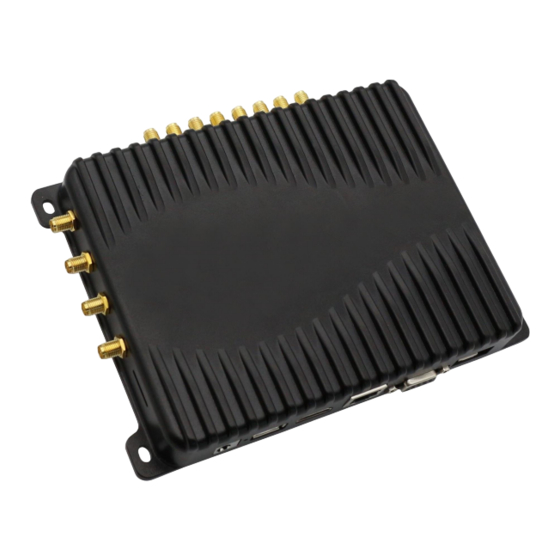
Table of Contents
Advertisement
Quick Links
Advertisement
Table of Contents

Subscribe to Our Youtube Channel
Summary of Contents for UROVO FR1000
- Page 1 Mobile Computer FR1000 User Guide Urovo Technology Co., Ltd. 20230522 v1.0...
- Page 2 Note: * This Guide introduced general functions of FR1000. Your PDA device may have different functions wherein or description. * There may be differences between the illustrations in this Guide and the actual product. And the actual product shall prevail.
- Page 3 Disclaimer All the user guides and specifications published by Urovo are correct. In the event of any wrong information, Urovo shall reserve the right to correct such errors but waive rights of liability and claim. Urovo shall not be liable for personal and property safety of users in the following cases: ...
-
Page 4: Table Of Contents
Index 1.Introduction ..........................5 1.1 Product Overview ......................5 1.1.1 Unpack ..........................7 1.2 Key Features ........................9 2.Specifications ..........................12 2.1 General Specifications ....................12 2.2 Network Antenna Interface ..................12 2.3 Specification Sheet ....................... 13 3.Assembly .............................16 3.1 Connecting Antennas ....................16 3.2 Connecting Peripheral Devices .................16 4.Operation ............................17 4.1 Starting Up the System .................... -
Page 5: Introduction
1.Introduction 1.1 Product Overview This manual provides information and instructions for operating the RFID Reader/Writer. The device is Android, with no built-in screen, if you need to demonstrate, you can connect external devices such as monitors, keyboards and mice to operate. The RFID Reader/Writer features eight read/write antenna interfaces, four network antenna interfaces, one SIM card slot, one DC interface, three USB interfaces, one RJ45 interface, one RS232 interface, one GPIO... - Page 6 20230522 v1.0...
-
Page 7: Unpack
1.1.1 Unpack a. device b. 4G & WLAN Antenna c. Power supply 20230522 v1.0... - Page 8 d. GPIO Cable e. GPS Antenna f. RFID Antenna(optional) 20230522 v1.0...
-
Page 9: Key Features
g. RF cable(optional) 1.2 Key Features Octa-core 1.6GHz Android 10.0 2GB+16GB Supports POE+ power supply 20230522 v1.0... - Page 10 Supports manual change of IPV6 address Supports 1920x1200P HD video output Supports GPS + GLONASS or GPS + BeiDou Designed based on Impinj E710 RFID engine, fully supporting electronic tags that comply with EPC CLASS1 G2 standards Protocol standards: EPC Global Class1 Gen2/ISO 18000-6C ...
- Page 11 Supports multi-channel optocoupler-isolated GPIO, with 4 inputs and 4 outputs, and isolation voltage VRMS>3kV Supports secondary development and remote online upgrade Compact and exquisite design, suitable for various application scenarios. Features: If connect with 9dBi Antenna, Long-range(9dBi, 30 meter) and ...
-
Page 12: Specifications
2.Specifications 2.1 General Specifications The RFID Reader/Writer has the following specifications: Operating system: Android 10.0 Input power: DC 13.6V Power consumption: Operating temperature: -30°C to 70°C Storage temperature: -40°C to 85°C Relative humidity: 5% to 95% non-condensing(+25℃) ... -
Page 13: Specification Sheet
2.3 Specification Sheet Model UROVO FR1000 Android 10.0 O.S. Performance Processor Octa-core 1.6 GHz Memory RAM:2GB ROM: 16GB Dimensions 180*128*28mm Display HDMI D Type interface; support 1920 x1080 P HD video output output Slot SIM x 1 antenna, main auxiliary... - Page 14 Connections Bluetooth Support BT5.0 Operating -30 ~ +70℃ Temp. Storage -40 ~ +85℃ Temp. Humidity <95% (no condensation) Sealing IP43 Supply 9 ~ 24V, typical value: 13.6V voltage Environment Working current Data Capture Specifications RFID(UHF) Read- write ( UHF) RFID Frequency 8 40 ~ 960 MHz (adjustable based on the requirements of different countries or regions)
- Page 15 WWAN parameters WWAN EGSM900 DCS1800 Frequency WCDMA B1, B8 band LTE-FDD B1, B3, B5, B8 LTE-TDD B34, B38, B39, B40, B41 ( 140 MHz) EGSM900: 5 dBm ± 5 dB~33 dBm ± 2 dB DCS1800 : ± dB~30 ± WCDMA B1, B8 : Minimum< -49 dBm ,...
-
Page 16: Assembly
3.Assembly 3.1 Connecting Antennas To connect the antennas, follow these steps: Connect one end of the RF cable to the main antenna interface of the RFID Reader/Writer. Connect the other end of the transmission cable to the read/write antenna. Note: For installation instructions, please copy the link and open it in your browser to watch the unboxing video: https://youtu.be/SeOwQd6nRF8 3.2 Connecting Peripheral Devices... -
Page 17: Operation
4.Operation 4.1 Starting Up the System To start up the system, follow these steps: Connect the power supply to the DC interface of the device, the device will automatically boot up. Connect the peripheral devices, such as a keyboard, mouse, and monitor, to the appropriate interfaces on the device. -
Page 18: Setting Up The System
b. copy the apk file into the folder of device and find it to install. 4.2.2 Setting Up the System Before using the RFID demo application, you need to set up the system by following these steps: Connect the antennas to the appropriate interfaces on the device. Connect the peripheral devices, such as a keyboard, mouse, and display, to the appropriate interfaces on the device. - Page 19 Select the Antenna port you connected and set it Go back to first page and test scan, or go to R/W page for the detail reading and writting. 20230522 v1.0...
- Page 20 20230522 v1.0...
-
Page 21: Troubleshooting
5.Troubleshooting In case of any issues or errors during operation, refer to the following troubleshooting steps to resolve the problem: Verify that all cables and connections are properly connected and secured. Ensure that the power source is sufficient and that the device is properly ...




Need help?
Do you have a question about the FR1000 and is the answer not in the manual?
Questions and answers